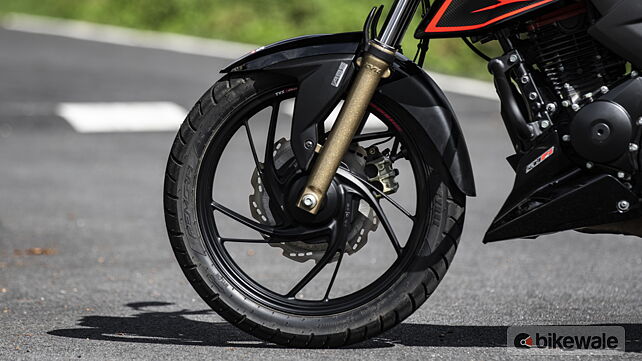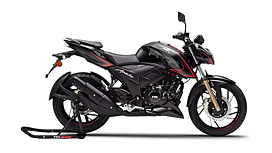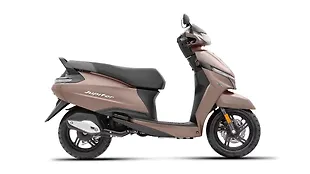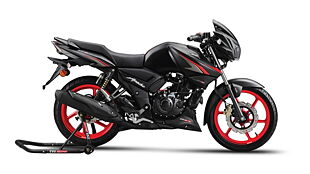Introduction

TVS had introduced the Apache RTR 200 4V back in 2016. And even today, it is well-known for its streetfighter styling, brisk performance and most of all, the agility it offers around the corners. So much, that I’ve found myself to be the owner of an RTR 200 4V for close to two years now. Being my daily workhorse and also the machine of my choice for a road trip, I was eager to experience what novelty the new BS6 compliant 2020 Apache RTR 200 4V brings to the table.
Over the span of three years, TVS has been regularly upgrading the bike both in terms of cosmetics and mechanicals. Up until now, TVS has offered the RTR 200 4V in several variants depending on the tyres, fuelling system and paint finish. Now, to avoid all the confusion, the company has introduced just one variant for the 2020 edition. That said, we were at the TVS’ test track located at its Hosur factory for the first ride of the BS6 compliant Apache RTR 200 4V. Let’s find out what TVS has in store for the 2020 edition.
The Visuals

The Apache RTR 200 4V has a streetfighter stance thanks to its aggressive front end with prominent tank extensions, followed by the dual-tone fuel tank and the split-seat design. The design is further accentuated by the double-barrel exhaust that looks the part and also has a powerful grunt that’s enjoyable. For the 2020 edition, while TVS has retained the overall silhouette of the motorcycle, it does receive a new headlamp unit with an edgier bikini fairing. The conventional filament bulb unit has been chucked away for a more modern all-LED setup. The assembly is flanked by claw-shaped LED DRLs on either side. Being a LED headlamp, TVS has paid special attention to its optimal operation by incorporating long-range light penetration along with a wider spread. Also, the light emitted by the LED units is set to deliver a warm tone that’s claimed to offer daylight simulation for better visibility at night. We will only get to know how much of a difference it has made once we have the bike for a detailed road test.

The LED headlamp is enclosed around a matte black plastic casing with body-coloured panels on either side. While the new headlamp and fairing give the streetfighter a more aggressive look, the quality and finish of the black plastic, especially around the edges don't appear to be up to the mark. Apparently, even the mounts for the turn indicators have been built using a lower grade of rubber/plastic. Not to mention, the paint surface is prone to a lot of scratches over the glossy surface. For a motorcycle that demands a sticker price exceeding the one lakh mark, the overall finish and feel of the new body panels along with the painted surfaces seem to be a result of cutting costs. Notably, the company officials claimed that this concern pertaining to the fit of the body panels will be resolved with the new motorcycles that roll out of the factory.

Furthermore, the 2020 Apache RTR 160 4V gets new race-inspired graphics, aerodynamically-designed claw side mirrors with a carbon-fibre like texture, seats with improved cushioning, brass-coated final drive chain, and a wave bite ignition key for better security. Besides these new upgrades, the motorcycle remains the same in terms of aesthetics.
The Package

The Apache RTR 200 4V is a motorcycle that TVS widely uses for its One Make Championship. Taking that into consideration, it would be safe to say that from the very first iteration, TVS has paid special attention to the dynamics and performance of the bike. And with these attributes in check, the RTR 200 4V is an enjoyable bike on the street. Even with the 2020 update, the hardware of the motorcycle remains the same.
Derived from learning at the track, the RTR 200 4V continues to sport the double-cradle split chassis. The motorcycle is suspended by telescopic forks up front and a monoshock at the rear. In terms of braking, the motorcycle comes with the disc brakes at both ends. There is a two-piston floating caliper for the front and a single-piston floating caliper for the rear. The system is equipped with dual-channel ABS as standard. While the previous versions of the RTR 200 4V came with multiple tyre options, the 2020 edition gets the Remora Series tyre at the front and a TVS Protorq radial tyre at the rear. This setup, according to the company, offers better grip around the corners and improved straight-line stability.

In case of the motor, the 2020 Apache RTR 200 4V continues to be powered by the same 197.75cc oil-cooled single-cylinder unit. The only major change is that the motor is now BS6 compliant while featuring a large catalytic converter and fuel-injection by default. To compensate for the new emission norms, TVS has increased the peak rpm for power and torque figures in order to keep the difference negligible. Now, the BS4 variant is already available with a fuel-injection option. TVS has revised the power and torque curve from its race-derived technology for the BS6 model and calls it ‘RT-Fi’ which stands for Race-Tuned Fuel Injection. Besides that, the NanofriKS coated piston now has an asymmetric light-weight construction which paired with the PVD coated piston rings results in an improved refinement. Lastly, the gear position sensor which would malfunction on the current models has been replaced by a contact-free sensor to prevent the wrong information from being displayed on the instrument console.

Speaking of the instrument console, the 2020 Apache RTR 200 4V gets the recently updated unit that is Bluetooth-enabled. Once linked to a smartphone (Android and iOS compatible) via a dedicated app, the user will receive call and message alerts, turn-by-turn navigation, race telemetry, lean angle and low fuel warning with assistance to the nearest fuel station.
Besides that, the RTR 200 4V has also been equipped with a new feature called Glide Through Technology (GTT) which allows the rider to get the bike rolling in bumper to bumper traffic without opening the throttle for a smoother ride.
The Ride

Owing to its racing pedigree, the Apache RTR 200 4V is a hoot to ride. The previous versions had a bit of roughness in refinement but with the 2020 edition, all that seems to have been ironed out. While there continues to be some vibration at higher rpm felt at the handlebar and footpegs, it can be attributed to the five-speed gearbox as the engine is working hard to achieve those speeds. Interestingly, despite the marginal difference in power output, the motorcycle takes some time to achieve its top speed. While the company claimed the top speed of the RTR 200 4V is about 129kmph, the test bike managed to clock 126kmph max even after back-to-back attempts. Other than that, the power delivery from the lower end of the bandwidth to the peak power rpm is consistent and linear. The motor felt just ready to instantly build up speed even at rolling speeds.

As for the brakes, they do a decent job of shedding speeds. Decent because, while the front brake offers good progression, it lacks the initial bite you expect on pulling in the brake lever. Also, there is no fixed point at which the brake lever stops which can be a concern during panic braking. For a bike of its performance, a sharper braking response would have been highly appreciated.
Our Take

Priced at Rs 1.24 lakhs, the 2020 Apache RTR 200 4V demands a premium of around Rs 10,000 over the out-going model which features the Smart Xonnect tech. For the additional cost, what you get is a BS6 compliant motor, all-LED headlamp, updated graphics and some new features. Now, that is a bit less for the premium being paid. But, when considered as a product overall, the 2020 Apache RTR 200 4V is still a good motorcycle in the entry-level performance segment.
Photography by Kapil Angane
Gallery
1/73
TVS Apache RTR 200 4V Front Wheel & Tyre
Double Tap to Zoom
























































![KTM 390 Adventure X [2025] KTM 390 Adventure X [2025]](https://imgd.aeplcdn.com/272x153/n/cw/ec/190885/390-adventure-x-2025-right-side-view.jpeg?isig=0&q=80)